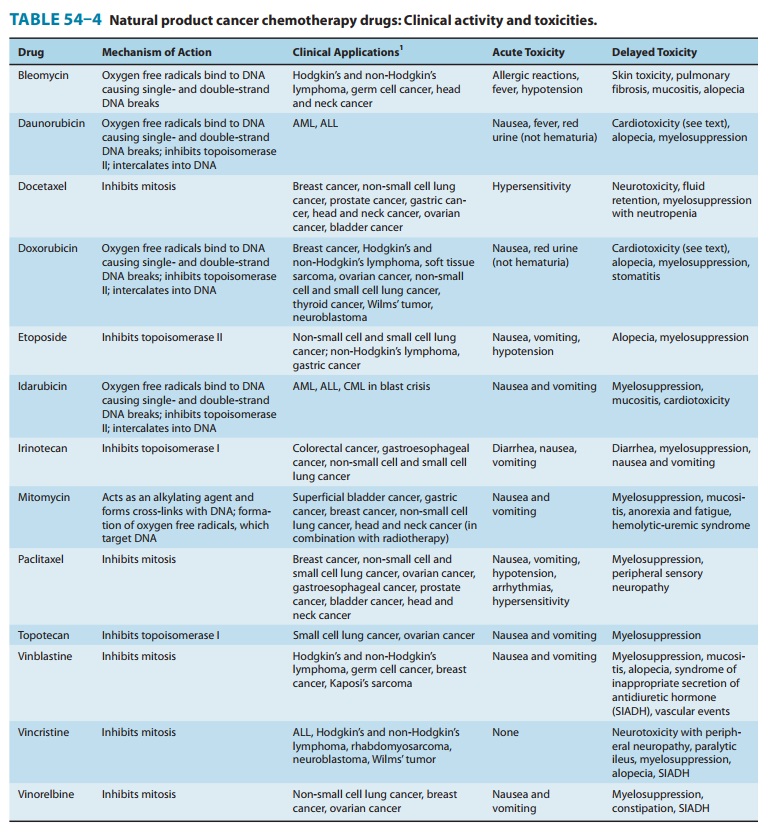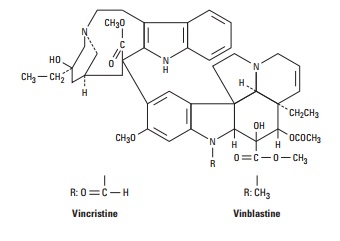Chapter: Basic & Clinical Pharmacology : Cancer Chemotherapy
Vinca Alkaloids
NATURAL PRODUCT CANCER CHEMOTHERAPY DRUGS
VINCA ALKALOIDS
Vinblastine
Vinblastine
is an alkaloid derived from the periwinkle plant Vincarosea. Its mechanism of action involves inhibition of tubulin
polym-erization, which disrupts assembly of microtubules, an important part of
the cytoskeleton and the mitotic spindle. This inhibitory effect results in
mitotic arrest in metaphase, bringing cell division to a halt, which then leads
to cell death. Vinblastine and other vinca alkaloids are metabolized by the
liver P450 system, and the majority of the drug is excreted in feces via the
hepatobiliary system. As such, dose modification is required in the setting of
liver dysfunction. The main adverse effects are outlined in Table 54–4, and
they include nausea and vomiting, bone marrow suppression, and alopecia. This
agent is also a potent vesicant, and care must be taken in its admin-istration.
It has clinical activity in the treatment of Hodgkin’s and non-Hodgkin’s
lymphomas, breast cancer, and germ cell cancer.

Vincristine
Vincristine
is another alkaloid derivative of V rosea
and is closely related in structure to vinblastine. Its mechanism of action,
mechanism of resistance, and clinical pharmacology are identical to those of
vinblastine. Despite these similarities to vinblastine, vincristine has a
strikingly different spectrum of clinical activity and safety profile.

Vincristine has been
effectively combined with prednisone for remission induction in acute
lymphoblastic leukemia in children. It is also active in various hematologic
malignancies such as Hodgkin’s and non-Hodgkin’s lymphomas, and multiple
myeloma, and in several pediatric tumors including rhabdomyosarcoma,
neuroblastoma, Ewing’s sarcoma, and Wilms’ tumor. The main dose-limiting
toxicity is neurotoxicity, usually expressed as a peripheral sensory
neuropathy, although autonomic nervous system dysfunction with orthostatic
hypotension, urinary retention, and paralytic ileus or constipation, cranial
nerve palsies, ataxia, seizures, and coma have been observed. While
myelosuppression occurs, it is generally milder and much less significant than
with vinblastine.
The
other adverse effect that may develop is the syndrome of inap-propriate
secretion of antidiuretic hormone (SIADH).
Vinorelbine
Vinorelbine is a
semisynthetic derivative of vinblastine whose mechanism of action is identical
to that of vinblastine and vincris-tine, ie, inhibition of mitosis of cells in
the M phase through inhibition of tubulin polymerization. This agent has
activity in non-small cell lung cancer, breast cancer, and ovarian cancer.
Myelosuppression with neutropenia is the dose-limiting toxicity, but other
adverse effects include nausea and vomiting, transient elevations in liver
function tests, neurotoxicity, and SIADH.
Related Topics